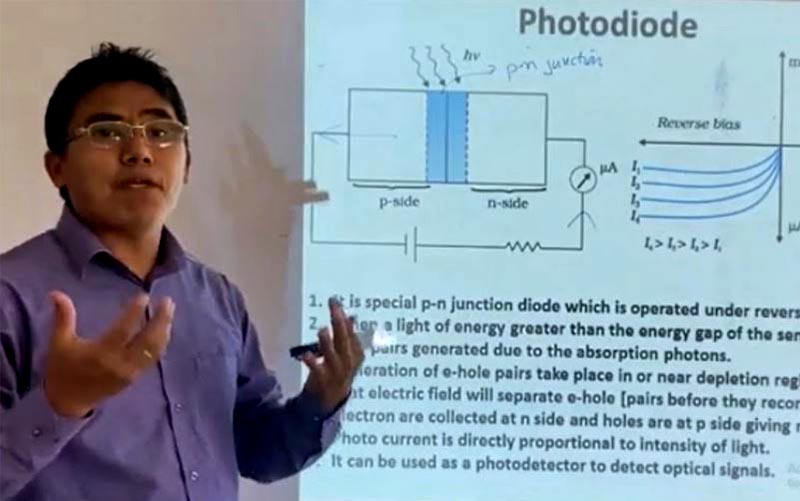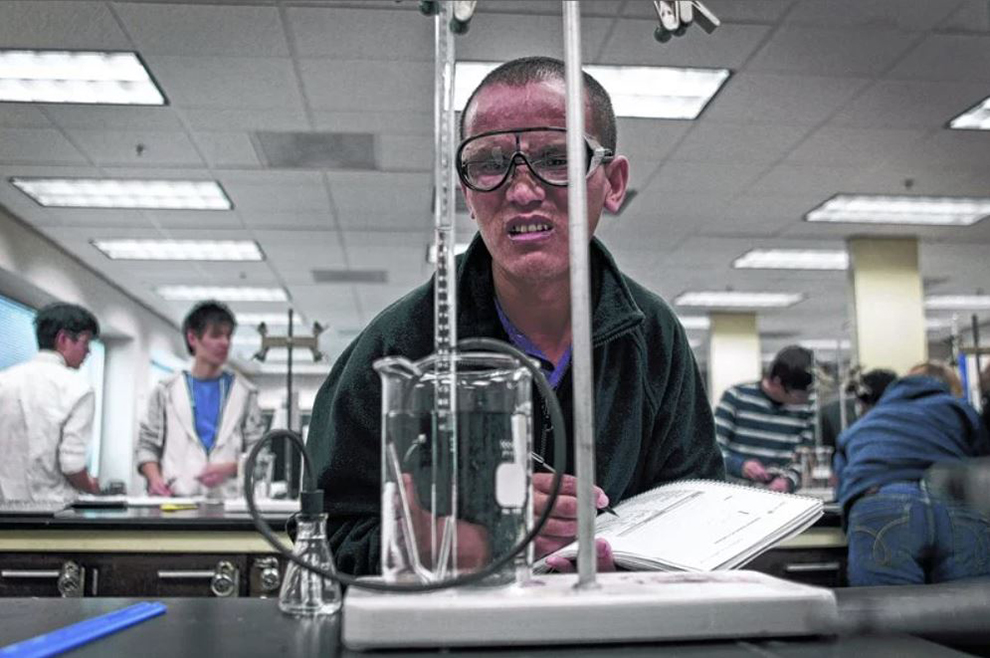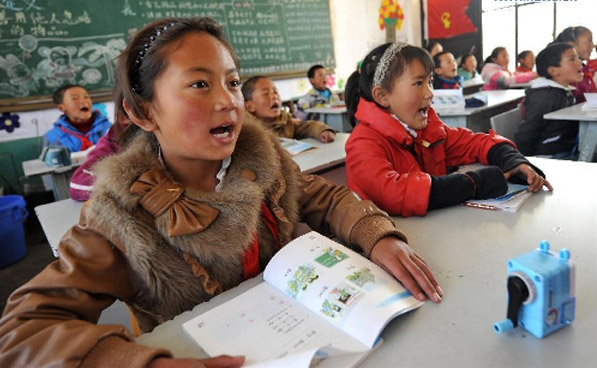(This piece is based on my reflection of a recent discussion about the state of science education in Tibetan schools at a webinar organized by Tibetan Scientific Society. Recording of the full discussion is available at the society’s Facebook page.)
By Tenzin Choephel, PhD*
(TibetanReview.net, Jan11’21)
Gen Karma Rinchen has been teaching physics at Tibetan Children’s Village (TCV) schools for about fifteen years. Having been through Tibetan school system in India himself and experienced the shortcomings of how science had always been taught, Gen Karma decided to do something about it, now as a teacher.
Like in most schools in India, the default mode of teaching science in exile Tibetan schools has traditionally been through lectures. A typical class may involve the teacher speaking most of the time, explaining scientific principles and theories in a top-down, often non-interactive, fashion. Lab classes are generally conducted to satisfy the requirements of the syllabus, not necessarily to demonstrate how real science is done through hands-on, experience-based, process. Assignments and exams are mostly focused on testing mere theoretical knowledge. The result is that this fascinating human endeavor called science is turned into a rather dry subject, devoid of the kind of excitement and wonder it should otherwise generate. It is hardly surprising, then, that students quickly lose interest. Many of them shy away from science streams after tenth grade. Even many of those who do end up enrolling in science streams, for various reasons, lose steam eventually, whether it is after the school-leaving board exams or after slogging away in college for a few more years.
Admitting the inefficacy of the traditional method, Gen Karma decided to experiment with a teaching approach that is more in line with how real science is done, a method that not only encourages critical thinking but also makes learning science more hands-on and exciting for students. He started teaching the concepts in physics by making his students in eleventh and twelfth grades conduct what are called “controlled experiments”.
A controlled experiment is one of several ways of doing science. It involves directly manipulating an experiment in order to test a single variable at a time. As an example, let’s say you want to study the effect of soil type on the germination of a seed. You could take several identical pots, fill each with a different type of soil, plant identical bean seeds in each pot, place the pots by a sunny window, water them equally, and measure how long it takes for the seeds in each pot to sprout. The experiment is controlled in the sense that you keep all the variables constant (control them) except for the type of soil, an independent variable, which varies between the pots. An advantage of controlled experiments is that you can eliminate much of uncertainty in your results and prevent a confusing outcome. This framework is simple yet, as Gen Karma learned, an effective way to teach students what it means to do science.

He initially applied the method of controlled experiment to lab practical classes at TCV Bylakuppe, India where he has been teaching for the past eleven years. Students generally don’t take lab classes very seriously. To many, it is uninteresting, confusing and seemingly too much pointless work. This situation is unfortunate because science pedagogy researchers believe that hands-on activity is one of the best ways to learn science. Gen Karma started conducting regular two-hour lab classes each week for eleventh and twelfth grade students by taking key concepts from each chapter in the standard physics textbook mandated by CBSE, the national educational board to which TCVs are affiliated, and systematically designing plans for controlled experiments.
One problem teachers and students have faced is the insufficient amount of time (usually one hour) that is allocated for lab, perhaps reflecting general apathy towards experiential learning activities. The goal of teaching scientific concepts and familiarizing students with the scientific method is defeated when the activity is rushed with the sounding of the bell. This is the reason why Gen Karma allocates at least two hours at a time for each controlled experimental class so that students have enough time to not only complete the experiment but also to reflect on the process.
Teaching is a hard job, and even harder for school science teachers. Mastering effective teaching involves doing constant pedagogical experiments in the classroom and paying close attention to what works and what does not. As and when Gen Karma implemented his new approach, he conducted what is called an “action research”, a form of investigation designed for use by teachers in an attempt to solve problems and improve professional practices in their own classrooms. It involves systematic observations and data collection which can be then used by the practitioner-researcher in reflection, decision making and the development of more effective classroom strategies (Parsons and Brown, 2002). Student surveys taken before, during and after two years of teaching lab classes through controlled experiments revealed that Gen Karma’s approach had worked. It dramatically improved students’ experience in conducting physics practical work. And combined with regular lectures, his method enhanced students’ understanding of physics concepts in general. Many students strongly agreed that after two years of “doing” physics through controlled experiments, they have started to enjoy their time in the labs more than they have in the past. Gen Karma grins with a sense of accomplishment when he shares these encouraging observations.
The benefits of hands-on learning in science are backed by research as Dr. Tenzin Sonam pointed out at TSENRIG Webinar Series 2020, hosted by Tibetan Scientific Society. An alumnus of TCV, Dr. Sonam is currently a researcher in the SEE (Social Emotional and Ethical) Learning Program at Emory University and holds a PhD in Teaching and Teacher Education. He quoted the National Research Council (2007) when he said, “Students learn science best when they are engaged in the practice of science”. Scientific practices include asking questions and developing problems, developing models, planning and carrying out investigations, analyzing and interpreting data, using mathematics and computational thinking, constructing explanations (science) and designing solutions (engineering), engaging in arguments from evidence, obtaining, evaluating and communicating information. More of these elements the teacher implements in his or her classroom, the better.

Dr. Sonam makes an interesting distinction between what he calls “scientist science” and “school science”. Scientist science is the science practiced by scientists. It starts with experiences of a phenomenon, followed by recognizing the patterns in it, and then coming up with explanations, models and theories that are carefully tested through experiments. It is an inquiry-based activity. In contrast, school science, the science that is taught in schools today, starts with extensive explanations, facts and definitions, followed by a few laws, diagrams and examples with limited exposure to the phenomenon being studied. Somewhere after the dry explanations of theories and facts, many students have lost interest and are already thinking about lunch or what they are doing during the next break. More of “scientist science”, Dr. Sonam believes, is what we must introduce in our schools if we were to make science more exciting for our students.
And this is exactly what Gen Karma has been doing with his teaching innovations at TCV Bylakuppe. Seeing that his efforts were paying off, he decided to go further by making his students apply scientific methods to science projects which are longer-term activities spanning several months. The idea here is to discourage students from just constructing static models and using other traditional ways of doing projects that can be easily copied from the internet or, interestingly, bought in the market! Known as Science Investigatory Project (SIP), this approach is somewhat of a departure from the traditional approach to school projects, and involves the student picking a problem or a phenomenon of his or her own choosing to investigate. The instructor helps the student frame the problem statement, if needed, so that it can be reasonably tackled. The student then uses the process of scientific inquiry to proceed from developing a hypothesis to drawing conclusions. Constant communication is maintained between the instructor and the student throughout the process. Positive and negative conclusions are equally entertained in this approach of doing projects as long as the methods of investigation are sound and the procedures are well-documented. This is an important point to note because it is exactly how real science happens – not all scientific endeavors yield positive outcomes; and negative results also help advance science. Gen Karma’s implementation of this method of conducting science projects has received much appreciation from teachers from local Indian schools.
Science is undoubtedly one of mankind’s greatest achievements. It has continuously extended the frontiers of our knowledge about the physical universe. Its applications continue to change the world in unimaginable ways and alleviate human suffering. Nations that have chosen to harness its remarkable powers have flourished while those which have chosen to stay away from it have fallen behind. It could be argued, historically, that Tibetans’ refusal to embrace science is partly responsible for their eventual capitulation to a technologically superior neighbor. This unwelcoming attitude towards science and modernism has given the colonizer an excuse to invade on the pretext of generously offering to modernize a country that had been stuck in a civilizational time warp. Acknowledging these hard facts, His Holiness the Dalai Lama has repeatedly encouraged Tibetans to make a concerted effort to build Tibetan human capital in modern science so that we are prepared for the future.
His Holiness’ clarion call for Tibetans to focus on Rigchik Kangzin (specialization) in various scientific fields was like a “Sputnik moment”. Many Tibetan science students, myself included, took on the challenge and went onto pursue master’s and PhD’s in their respective fields. Central Tibetan Administration (CTA) in Dharamsala has since increased scholarship and fellowship opportunities for Tibetans pursuing higher education in scientific and technical fields. However, unless more effort goes into improving science education in Tibetan schools today to keep students interested, many of these awards and grants will remain unused in the future. And that will be a big waste!
Improving science teaching in Tibetan schools requires teachers to innovate with new methods based on the latest pedagogical research as well as learnings from their own classroom experiences. It requires them to spend more time than they have in the past in order to research and carefully design their classes. On its part, the administration, at the school or CTA level, must support and incentivize science teachers like Gen Karma Rinchen who have gone out of their ways to improve learning experiences for their students. This will not only send a positive and encouraging message to these hardworking men and women but also encourage more qualified Tibetans who are passionate about science to consider becoming science teachers. Rethinking science teaching in our schools will truly go a long way in preparing ourselves for the future, scientifically and technologically.
References:
Parsons, Rick D., and Kimberlee S. Brown. Teacher as Reflective Practitioner and Action Researcher. Belmont, Calif.: Wadsworth/Thomson Learning, 2002.
Acknowledgement:
I would like to thank Gyen Karma Rinchen for allowing me to share his story and to Dr. Tenzin Sonam and my colleagues at Tibetan Scientific Society for their comments on this article.
—
* Tenzin Choephel is an Aerospace Engineer at Pratt & Whitney, NY, in the United States and a board member of Tibetan Scientific Society.





